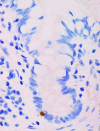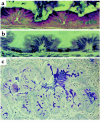Gut instincts: thoughts on intestinal epithelial stem cells
- PMID: 10841502
- PMCID: PMC300863
- DOI: 10.1172/JCI10229
Gut instincts: thoughts on intestinal epithelial stem cells
Figures




References
-
- Potten, C.S. 1995. Structure, function and proliferative organisation of the mammalian gut. In Radiation and gut. C.S. Potten and J.H. Hendry, editors. Elsevier Science. Amsterdam, The Netherlands. 1–31.
-
- Kaur P, Potten CS. Cell migration velocities in the crypts of the small intestine after cytotoxic insult are not dependent on mitotic activity. Cell Tissue Kinet. 1986;19:601–610. - PubMed
-
- Potten CS, Loeffler M. Stem cells: attributes, cycles, spirals, pitfalls and uncertainties. Lessons for and from the crypt. Development. 1990;110:1001–1020. - PubMed
-
- Hendry JH, et al. The response of the murine intestinal crypts to short range prometheium-147 radiation. Radiat Res. 1989;118:364–374. - PubMed
Publication types
MeSH terms
Substances
LinkOut - more resources
Full Text Sources
Other Literature Sources
Medical

